This post will explain what kinds of bearings are (mostly and usually) used with bicycles and what their advantages and disadvantages, compared to other commonly used bicycle bearing systems are. For bearing ball standards, see: Standard bicycle bearing ball sizes.
1. Cup and cone bearings
Bicycle bearings commonly use bearing balls, placed in a cone, compressed with a cup (cup and cone bearing). Cup, with curved walls holds the balls, while the cone presses on top, holding them in place.
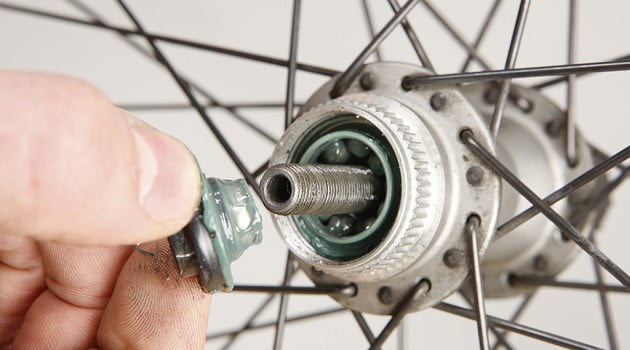
Cone is screwed onto the axle and presses the balls onto the cup.
Advantages
Durability. A good cup and cone bearing, when lubricated regularly (once a year is often enough) and with regular ball replacement can last practically forever. Instructions for servicing cup and cone bearings are in this post: Bicycle hub overhaul.
Cheap maintenance. All the spare parts needed for servicing these bearings are new balls and a bit of grease. Replacement balls are very cheap and easy to find in all the standard sizes.
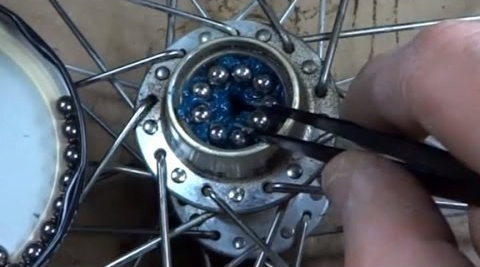
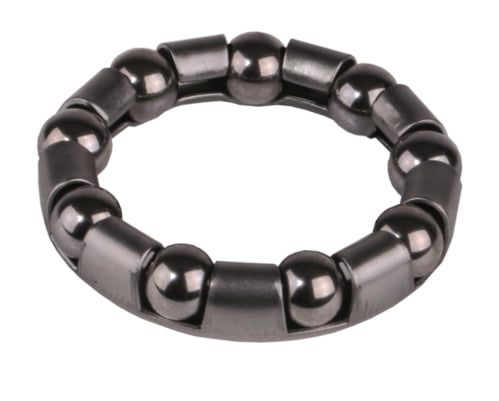
Good load distribution. With (angled) cup and cone bearings, load is spread more evenly than with radial bearings. These bearings handle both radial (up-down) and axial (side) loads better.
Low rolling resistance. Balls roll easily, without too much friction.
Disadvantages
A bit tricky setup. Setting the optimal cone preload takes a bit of patience and practice. Explained in the Bicycle hub overhaul post.
Greater damage in case of irregular maintenance, compared to cartridge bearings. If this type of bearing is not cleaned and re-lubricated regularly, first thing that wears out are balls (easily replaced). If it is still not re-lubed, next thing that goes are the cones. Cones are a bit more expensive and often hard to find for the particular bearing model. In case bearing isn’t cleaned and re-lubed after the cones are worn, next thing that gets worn are cups. This is usually irreparable damage, calling for hub replacement (in case of wheel bearings), headset bearing replacement (in case of steerer bearings), or pedal replacement (in case of pedal bearings). That is why regular maintenance is important with cup and cone bearings.
2. Cartridge bearings
Modern trends are leaning towards cartridge bearings. It consists of a cartridge, that is inserted in a “sleeve” in the appropriate bicycle part that needs to turn – a wheel hub, headset, BB shell etc.
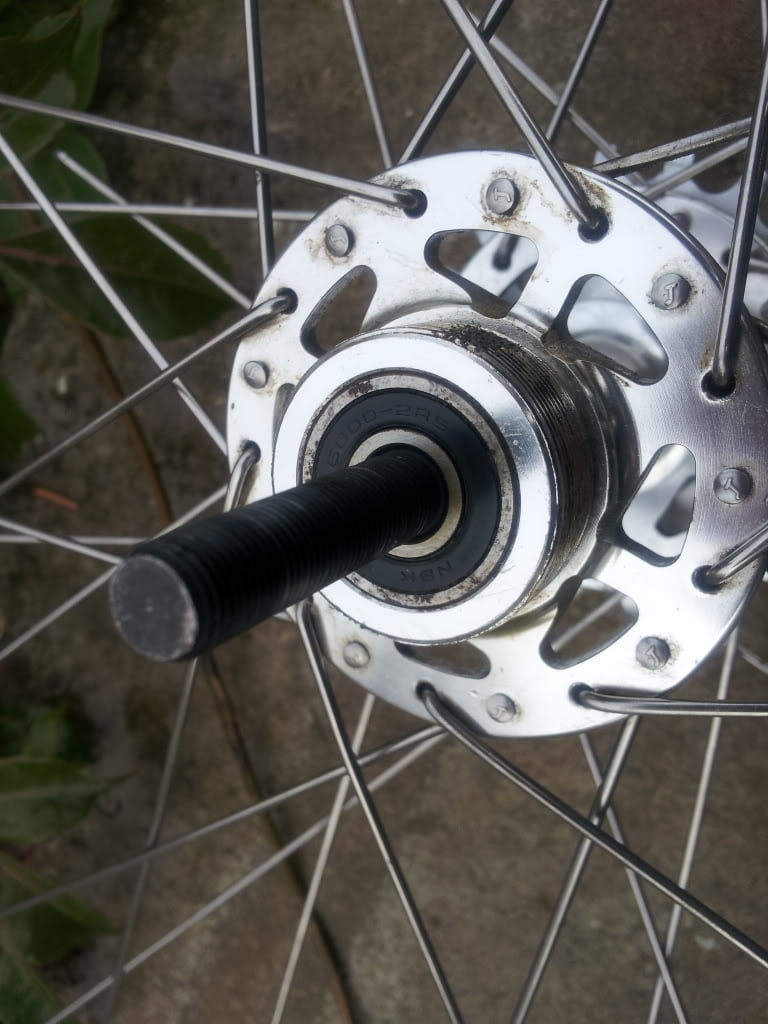
Balls are packed with two races in a “sealed” cartridge. Sealed as can’t be disassembled, not as (completely) sealed from dirt and water! On top there is usually some sort of plastic, or rubber seal. These seals don’t prevent dirt and water from entering the bearing – just slow the contamination down a bit. That’s why these bearings too need to be cleaned and lubricated to last longer.
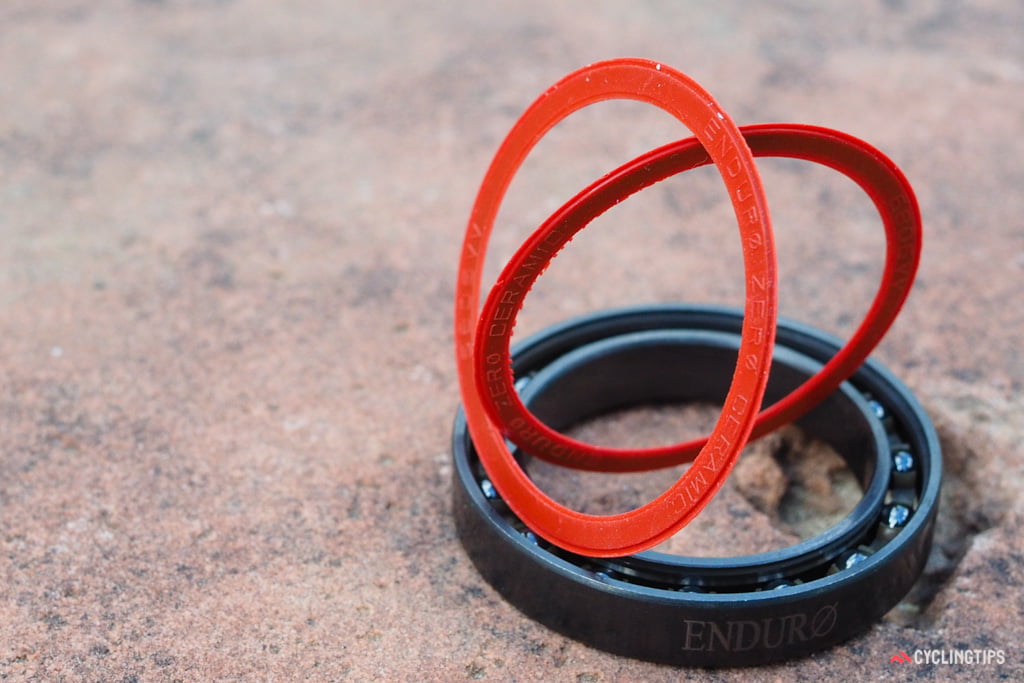
These bearings are not better than the old and tested cup and cone system. But they are cheaper to produce in decent quality, than cup and cone bearings.
Advantages
Negligence resistant. 🙂 Advantage compared to cup and cone bearings is that, even if very neglected and totally worn, only cartridges are replaced – just like non-worn cartridges. Cup and cone hub bearing, for example, calls for the whole hub replacement in case cups get worn. With cartridge bearings, only cartridges are replaced, so hub would be fine, even in case of a totally busted old cartridge needing replacement.
Simple and straight forward replacement. No need to fine tune preload like with cup and cone bearings.
Low rolling resistance, like cup and cone system. At least while they are new.
Disadvantages
More expensive service. Balls can’t be replaced in cartridge bearings. So within a finite amount of time the bearing cartridge will need to be replaced. Cartridges are a bit harder to find and a bit more expensive than balls. Tools for servicing are also a bit more expensive. Bearing puller tools are needed, to remove the cartridges without damaging the rest of the bearing.
Difficult cleaning and re-lubrication. Before they are worn for replacement, but when they get dirty, servicing is harder than with cup and cone system. As it was mentioned before, seals on these bearings only slow down dirt and water contamination, but don’t prevent it. These bearings can’t be opened so that balls can be taken out (and/or replaced), and all the dirt wiped off. It is only possible to take cartridges out and wash them with some degreaser, then stuff them with fresh grease. Takes longer and it’s still not as thorough as with cup and cone system.
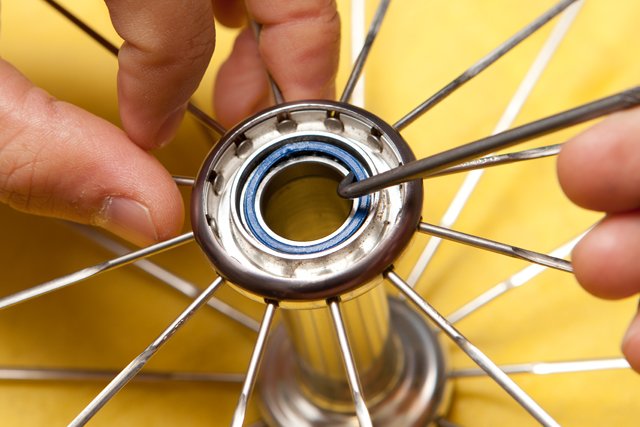
Worse handling of axial loads. Cartridge bearings are usually radially designed, i.e. ball races are symmetrical and deal well only with radial loads (up and down), not with axial (side) loads – like present when pedalling hard out of the saddle. There are “angular” versions of cartridges that take axial loads better, but they are not that widely available.
2.1.Ceramic and special cartridge bearings
There are special versions of cartridge bearings designed to be “faster”, i.e. to have as low rolling resistance as possible. How is this achieved?
Zero contact seals. Seals don’t overlap bearing races. This means a little less drag, but also easier way for dirt to enter the bearings. This means the bearing will be “faster” when brand new, but stop being faster and even become slower very quickly with use, than a comparable bearing with an overlapping seal.
Softer greases. Of lower NLGI number, i.e. lower consistency (hardness). Less “thick” so to say. These greases provide lower rolling resistance, but wash out more quickly and don’t prevent bearing wear as well.
Ceramic balls. With standard bearings, both balls and races are made of steel. Bearings with ceramic balls are often marketed as “ceramic bearings”, even though only balls are ceramic, while races are still made of steel. Ceramic balls can be machined to be smoother surfaced than steel ones. They are also harder, more wear resistant. So, these bearings are advertised as faster and longer lasting. However, since steel is softer than ceramics, ceramic balls will quickly pit and damage the softer steel races. Resulting in a bearing that lasts shorter than a comparable “full-steel” ordinary bearing. It will also quickly produce more drag and develop play.
Completely ceramic bearings. These bearings have both balls and races made of ceramics. Because of great hardness of ceramics, they need to be machined to very tight tolerances. If they are of high quality (expensive) they will be faster and last longer than ordinary steel bearings. However, hard and brittle ceramics is more likely to be damaged from a hard impact.
Bottom line: these bearings provide some advantage to racers, for a race or two, then being replaced. My personal opinion is that for other uses, good quality ordinary steel bearings are a better choice.
3. Roller (“needle”) bearings
These bearings consist of two conical races and a cage holding conically placed rollers. They are often (wrongly) called needle bearings (needle bearings have a lot longer and thinner “rollers” – resembling needles).
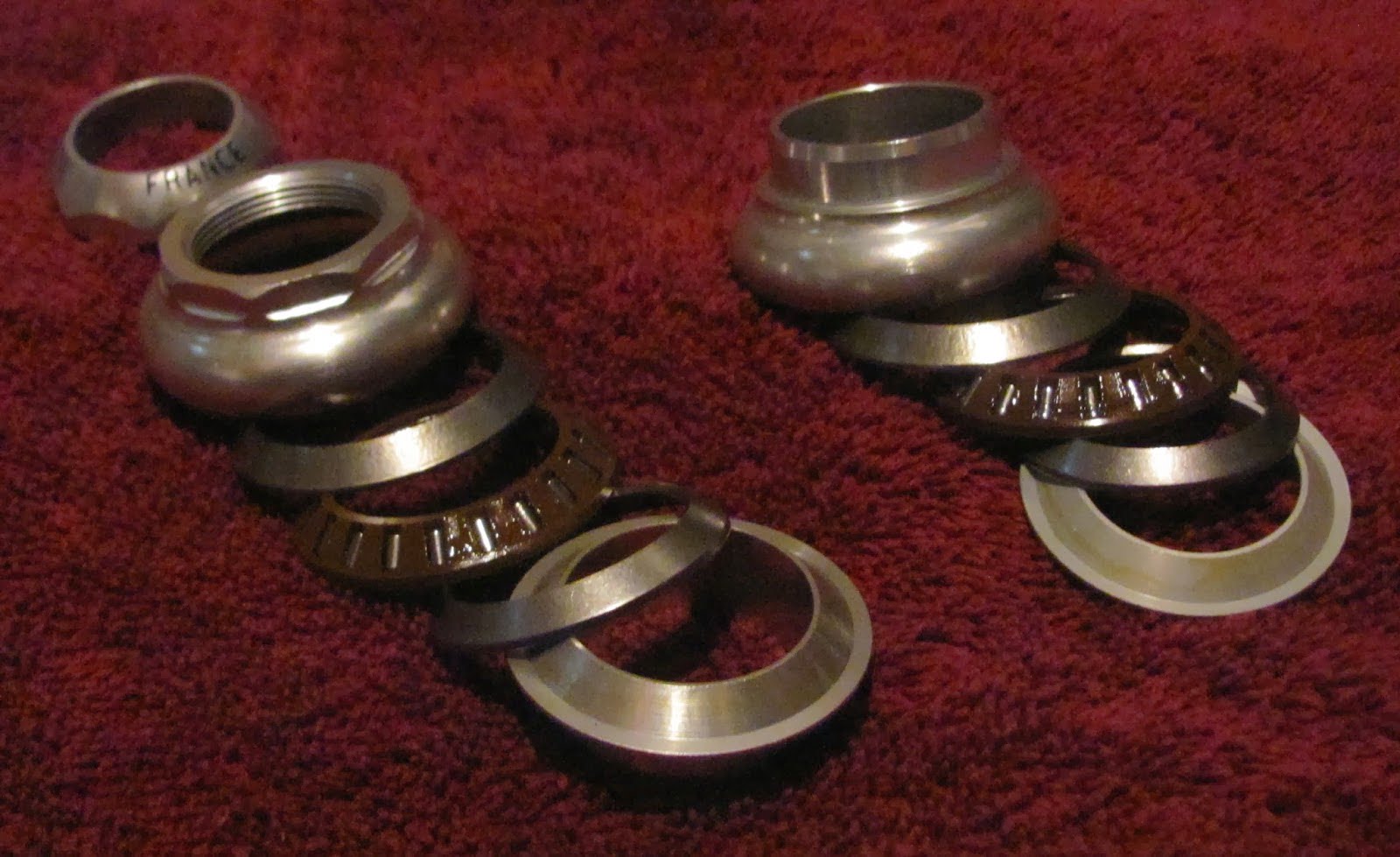
Rolling resistance is higher than with ball bearings, but they can handle a lot higher loads, because of a greater contact area with races that rollers provide, compared to balls.
They are used as headset (steering) bearings on some (older) bicycles. The fact these bearings make more rolling resistance is irrelevant for this use, since handlebars are not turned around all the time – only moved from time to time to steer. Using slightly (unnoticeably) more force to turn the bars does not affect speed, nor steering precision.
On the other hand, greater drag can be even beneficial for steerer bearings. How so? Some bicycles, when riding fast down a hill, produce what is called a “high speed shimmy”. I.e. handlebars start shaking. Higher drag of steerer bearings reduces the chances of a shimmy occurring, and if it does occur, slightly reduces the severity of it.
They are seldom used in modern bicycles. One of the reasons was lower durability. Such bearings are poor at handling forward-back movement of steerer tube when riding over road bumps.
4. Author’s personal opinion
For wheel (hub) bearings, the best system is old cup and cone. Shimano, with their middle class hubs (Deore for MTB and Tiagra for road) offers the best “bang for the buck”. For non-race use, it makes little sense using anything more expensive.
For steerer bearings, any decent quality ones will do.
Special bearings, especially if paired with softer greases, are a waste of money, except maybe for top class racers.
Related post – Bicycle bearing grease:

Sources
- BikeRadar – Bicycle bearings: everything you need to know
- Rolling Bearing Analysis; Tedric A. Harris (Amazon affiliate link – as an Amazon Associate I earn from qualifying purchases.)
Last updated:
Originally published:

Hi Relja,
I just stumbled onto your website and like very much what I see, excellent job ! Congratulations!
Interesting that you don’t recommend going above Deore for cup and cone bearings. I have also read that Deore and XT are almost identical.
By Deore I understand M525 or above, is that right ?
Well my question is, how compatible are the cones across Shimano ranges?
I have the misfortune of having a good bike with bad hubs, the infamous M475. The cones are pitted but the cups “seem” ok. Normally the cones wear more that the cups. To avoid replacing the wheels I have thought of changing balls and cups but using better quality cups from a higher range. What do you think ? Can I mount M525 or even XT cones on my M475 hubs?
Thanks
Eric
In my experience, cones are more often different (incompatible) than not. Shimano tech. pages provide info on part numbers and design.
There you can find the manuals and info for most components. FH-M475 spare part number chart. M525 spare part number chart.
So these are apparently different/incompatible.
Having said that, in my experience, with proper hub service – regular/anual cleaning and re-lubing, even with reusing old bearing balls, Shimano hubs last for decades, even the “lower end” ones. On the other hand, hubs come from factory with too much preload usually and if installed and run without previously setting that properly, even the XT ones get pitted cones relatively quickly. Some salesmen/mechanics go out of their way to explain that to customers, while some prefer not to tell customers to (pay for the) service of brand new hubs.
Being on the inside and of smaller diamater, cones take more damage more quickly, so it is often the case that hubs can be saved by just replacing cones and bearing balls. For your hubs, left hand cone Shimano model is Y22098080, while the right hand cone is Y30G90500. Online (I’ve provided Amazon affiliate search links), or local bicycle shops are the places to look for them.
As for Deore – by Deore I mean the “basic” Deore, as in not LX, XT etc. 🙂 Whatever the current model designation of a particular hub is/has been. M475 are quite decent quality hubs and should last a long time with proper service in my knowledge and experience. In fact, my all year haul everything bike front hub is an M475, doing fine. 🙂 Didn’t know they were “infamous”? Did many people have problems with those hubs? What I don’t like about them is the 6-bolt disk attachment system (a poor design, centerlock is a proper one), but that has nothing to do with the bearing quality (and I use rim brakes 🙂 ).
Relja
Thanks Relja for your reply,
These hind have plenty of bad reviews in many forums, the sealing seems to be a problem. Some oropendola even claim that they only lasted moths.
Just an example:
http://forums.mtbr.com/shimano/worst-shimano-hubs-ever-shimano-hb-m475-viam-370908.html
They are sometimes rated as Alivio though many say that it is a “non series” item, not belonging to any family or range. .???
I have a Trek 550 with 5000 Kms on it, with heavy loads mostly, and both hubs are damaged, pitted cones, the front had even cracked bearings. Admittedly the locknut had loosened on tour and I noticed only too late. Surely and annual service would lengthen its life, but I remember having several bikes as a Kod and teenager that went through decades if abuse without even having a hub serviced.
Not the hub I would choose fit my bike, but now I want to try to salvage my wheels without having to relace them with another hub. And upgrade them if I can. The cones in tne M475 have a different part number that higher en cones, M525 and above, but they may still be compatible. If the races and measurements are the same ( if the balls are tne same size the races should have the same geometry) I think I could mount them and get a cone with better material and better sealing, a welcomed upgrade.
Higher en cones have the races inlaid with a chrome coloured harder material whereas lower ones like M475’s are plain dark steel, they may be interchangeable but the different material may account for the different part number. That is what I have to find out. Ideally I would have to compare them side by side. But that is not easy, not many shops stock cones, they are readily available online but I cannot see the full specs, not even the Shimano pages you link have that info.
One has a lot to learn and your site is an excellent resource.
Eric
I’ve read the thread. Several posters did note the preload adjustment as a probalbe problem cause. Some have said they use both 475 and XT with no problems.
For all I know, it’s a Deore class component, perhaps not “issued” within a complete groupset, but afterwards/before, as a “non-series” hub set.
By the way, in my knowledge and experience, “ordinary” Deore hubs are more durable than XT ones. XT are lighter.
As for old bikes, a few years ago I had serviced and old Czech rear hub that hadn’t seed service in decades (but not too much riding either). It had grease completely dried out – as baked onto the hub, hard to remove without bathing it in degreaser. It had a bearing ball split in half and rusted. But no damage on cups and cones! That hub was hardened to a very very hard hardness. 🙂 They don’t make them like that any more. Just like Shimano from 30 years ago is not the same durability as today (I have some 1974. dura Ace rear hub still going strong, and have seen numerous 20+ year old Shimano 600 hubs in top shape). Unfortunately, that can’t be compared.
Still, with proper preload and service, hell, my winter bike (that missus rides during nice weather period) has cheap Chinese Quando hubs and they last for years and thousands of kilometres with regular service! Shimano, even the 475 is way better than those. Knock on wood, but my 475 has seen lots of rain and dust and still runs with no problems or pitting.
Run even the best hubs with too much preload, or with loose bearings – and you’ll ruin them in no time. This autumn a competitor brought some relatively new XT wheels for service and as soon as I saw the preload was off, I had warned him about possible cone damage. Opened hubs – voila, pitted cones (we found new ones, cups were fine).
For interchange of cones – they use the same threading and cups seem to have the same curvature, so the cones should too. It boils down to getting the OLD right, since they vary in cone and lockring thickness. Also, dust seals may be different – do check the pdf-s I’ve linked in the previous reply to see if they will match.
Whatever you decide in the end – proper preload and regular service are the key. Cup and cone bicycle hub bearing design is superrior to cartridge bearing hubs, but it needs regular servicing, otherwise the damage is more expensive.
Hello, I am sorry but I have to disagree with the statement that “sealed cartridge bearings are NOT better than cup and cone.”
In the late 1990’s I gave up dirt biking for Mountain biking. I started out with Wally worlds bikes and they only lasted 6 months. I finally got more serious and bought a Trek 4300. Where the cheap bikes had loose bearings in the bottom bracket, The Trek has sealed bearings in the bottom bracket. World of difference. It was easier to pedal and no slop or looseness with the sealed bearings. With this discovered, I bought a Vuelta wheelset that has-sealed cartridge bearings. No more looseness of the wheels, a whole lot sturdier and very very smooth. My latest bike is an ebike that bonce again came with cup and cone wheels, and when I upgraded to the sealed cartridge bearings it wasv totally different. Try the test sometimes! Sealed cartridge bearings ARE BETTER
Good quality cup and cone bearings have no looseness and work well.
I don’t run any cartridge bearing hubs on any of my bikes, but I’ve been using cartridge bearing bottom brackets for decades (along with some cup and cone ones).
The main advantage of cartridge bearings is there is no total damage if they aren’t serviced regularly (I do appreciate not having to service bottom brackets on every bike, every year). You can just replace the whole bearing. With cup and cone wheel bearings, if a cup gets damaged, it usually calls for relacing the wheel with a new hub.
But in terms of performance, good quality cup-and-cone bearings work wonderfully.
Relja